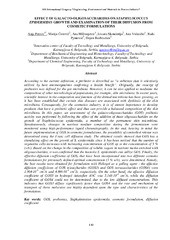Приказ основних података о документу
EFFECT OF GALACTO-OLIGOSACCHARIDES ON STAPHYLOCOCCUS EPIDERMIDIS GROWTH AND EXAMINATION OF THEIR DIFFUSION FROM COSMETIC FORMULATIONS
| dc.creator | Petrov Ivanković, Anja | |
| dc.creator | Ćorović, Marija | |
| dc.creator | Milivojević, Ana | |
| dc.creator | Skenderija, Jovana | |
| dc.creator | Vukoičić, Ana | |
| dc.creator | Pjanović, Rada | |
| dc.creator | Bezbradica, Dejan | |
| dc.date.accessioned | 2023-03-13T13:44:55Z | |
| dc.date.available | 2023-03-13T13:44:55Z | |
| dc.date.issued | 2021 | |
| dc.identifier.isbn | 978-99955-81-38-1 | |
| dc.identifier.uri | http://TechnoRep.tmf.bg.ac.rs/handle/123456789/6049 | |
| dc.description.abstract | According to the current definition, a prebiotic is described as “a substrate that is selectively utilized by host microorganisms conferring a health benefit”. Originally, the concept of prebiotics was defined for the gut microbiota. However, it can be also applied to modulate the composition of other microbiological populations, for example, skin microbiota. In recent years, scientific interest in the composition and function of the dermal microbiota has been growing, as it has been established that certain skin diseases are associated with dysbiosis of the skin microbiota. Consequently, for the cosmetics industry, it is of utmost importance to develop products that have a prebiotic effect and thus can provide a balanced composition of the skin microbiota. In this paper, an assessment of the galacto-oligosaccharides (GOS) prebiotic activity was performed by following the effect of the addition of these oligosaccharides on the growth of Staphylococcus epidermidis, a member of the permanent skin microbiota. Simultaneously, changes in nutrient medium composition during the fermentation were monitored using high-performance liquid chromatography. In the end, bearing in mind the future implementation of GOS in cosmetic formulations, the possibility of controlled release was determined using the Franz cell diffusion study. The obtained results showed that GOS has a stimulating effect on the growth of S. epidermidis since it has been noticed that the number of vegetative cells increases with increasing concentration of GOS up to the concentration of 5 % (w/v). Based on the change in the composition of soluble sugars in nutrient media enriched with oligosaccharides, it was confirmed that the bacteria S. epidermidis can utilize GOS. Finally, the effective diffusion coefficients of GOS, that have been incorporated into two different cosmetic formulations for previously defined optimal concentration (5 % w/v), were determined. Namely, the best results were obtained for formulation with Heliogel as a gelling agent - the effective diffusion coefficients of GOS trisaccharides (GOS3) and GOS tetrasaccharides (GOS4) were 1.904·10-6 cm2/s and 4.696·10-9 cm2/s, respectively. On the other hand, the effective diffusion coefficient of GOS3 in hydrogel Aristoflex AVC was 5.148·10-8 cm2/s, while the diffusion coefficient of GOS4 could not be determined, due to the low diffused concentrations. This indicates that GOS3 diffuse significantly faster than GOS4 and the rate and mechanism of transport of these molecules are highly dependent upon the type and characteristics of the formulation. | sr |
| dc.language.iso | en | sr |
| dc.publisher | Faculty of Technology, University of East Sarajevo | sr |
| dc.rights | openAccess | sr |
| dc.rights.uri | https://creativecommons.org/licenses/by/4.0/ | |
| dc.source | VII International Congress “Engineering, Environment and Materials in Process Industry“, Jahorina, Republic of Srpska Bosnia and Hercegovina, Book of abstracts | sr |
| dc.subject | GOS | sr |
| dc.subject | prebiotics | sr |
| dc.subject | Staphylococcus epidermidis | sr |
| dc.subject | cosmetic formulation | sr |
| dc.subject | diffusion coefficient | sr |
| dc.title | EFFECT OF GALACTO-OLIGOSACCHARIDES ON STAPHYLOCOCCUS EPIDERMIDIS GROWTH AND EXAMINATION OF THEIR DIFFUSION FROM COSMETIC FORMULATIONS | sr |
| dc.type | conferenceObject | sr |
| dc.rights.license | BY | sr |
| dc.citation.issue | ENG-97 | |
| dc.citation.spage | 140 | |
| dc.identifier.fulltext | http://TechnoRep.tmf.bg.ac.rs/bitstream/id/16032/ENG-97-ABSTRACT.pdf | |
| dc.identifier.rcub | https://hdl.handle.net/21.15107/rcub_technorep_6049 | |
| dc.type.version | publishedVersion | sr |

